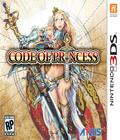The renaissance of old video game genres is upon us, and one of the genres that has benefited is the side-scrolling beat-'em-up. While games like Lucha Fury and Unbound Saga are affairs of varying quality, other titles like Castle Crashers, Double Dragon Neon and Scott Pilgrim vs. The World show that great games can still be made in a genre that saw its glory days during the 8- and 16-bit eras. While this has largely been spearheaded by Western developers, Eastern developers have embraced some of those ideas, as evidenced by Code of Princess for the 3DS.
For centuries, humans and monsters have co-existed, with some minor conflicts forcing them to cross paths. After some time, the monsters grew restless and started to invade the prosperous human kingdoms. Led by Queen Distiny, who uses the monsters to invade and her soldiers to falsely put up a front to gain the trust of the townspeople, the monsters have finally arrived at the kingdom of DeLuxia, where they seek a special sword. As princess of her kingdom, Solange Blanchefleur de Lux was instructed by her father to protect the sword DeLuxcaliber from evil forces. After the siege at the castle, her estate is in ruins, but the sword protects her from death. With the help of some friends, she tries to stop the monsters — and Distiny's plans.
The story stands out because of the characters, who have undergone good localization. A majority fall under the typical anime tropes you've come to expect from most Japanese games: the sheltered but well-meaning main character, a cute little kid who's overly vicious, flamboyant ninjas and a troublemaking bard. They play their roles well, but the dialogue makes their scenes more entertaining. You'll get classic gags, such as two henchmen debating their names and greatness. You'll get dialogue about how classic RPG parties always need a healer or how the scantily clad Solange can wear such revealing clothing in battle. Kudos to the localization team for making the game the equivalent of Disgaea in terms of being intentionally funny and succeeding at it.
The gameplay should be familiar to fans of Guardian Heroes, especially since a bulk of the development team was also responsible for that Sega Saturn cult classic. For the most part, the game is a classic beat-'em-up. Each level is a small arena where you must defeat a number of enemies and their big boss in a set amount of time. The battles are bookended by cut scenes. The game is presented in the classic side-scrolling manner, but unlike most beat-'em-ups, the battlefield has three distinct planes of movement instead of one. A little bit of vertical movement ensures a clear line of attack.
Players can choose one of four combatants to play for the level, and they and gain experience points for that character should they finish the level. In typical RPG fashion, the experience helps you gain levels, which give you points to spend on basics like health, magic, power, etc., and the same goes for items you acquire after each fight, whether it's through the battlefield or in shops.
RPG stat-building aside, there are a few mechanics that sets apart Code of Princess from others in the genre. There's a lock-on system that puts your attack focus on one enemy. For melee attacks, you'll still need to be on the same plane as the locked-on foe to inflict damage, but projectiles do fine across all planes. In both cases, locking on to an enemy means you'll deal double damage to that enemy, making it a worthwhile move in certain situations. Burst mode uses up your magic points to give you double damage for a limited amount of time, and combining them with your combos makes your fighter very lethal in any situation.
If anything, that is certainly one criticism that can be levied against the game. The combos are very devastating, with a number of them able to hit multiple opponents at a time. The double damage from any of the special abilities is powerful, but the quadruple damage makes you almost unstoppable — even during very big boss fights. You gain this early on in the game, before you get a chance to form half of your party. Thanks to this and the constant leveling you can do, you'll never really feel like you're being challenged even when facing the final bosses. Players who want some difficulty will be disappointed that the constant grinding is only a means to see the next cut scene.
If you're fine with wielding such power early on, the main campaign is quite enjoyable thanks to a number of factors. The campaign is quite lengthy, giving you several hours of entertainment just for one character. Each of your four characters has a different fighting style, and while it is annoying that you can't have them receive experience when your chosen character fights, the encounters are slightly different depending on who you choose. Should you find yourself stuck, you have the opportunity to go back and farm older levels for experience, making it easier for most players to beat the campaign.
Once you finish the campaign, there's still plenty of game left. Playing through the main campaign gives you tons of bonus missions for a substantial amount of gameplay. You can unlock just about every single character you meet for play in both the bonus levels and the separate campaign levels designated for free play. It's gratifying to see giant ogres swat away lots of regular soldiers since there aren't many brawlers that let you take full control of just about everyone you've beat up along the way. While the casual fan may not appreciate it as much, the more dedicated players will love having that kind of control.
A game like this was built with multiplayer in mind, and it's good to see that there are several options for those who don't want to play solo. Local players can play the game cooperatively with up to three other players as they go through any quest and earn XP. They can also decide to play in a versus mode, pitting any character against one another to see who's the strongest. In both cases, each player must be equipped with their own game card to participate. That's an understandable restriction since the modes contribute XP for your chosen character, but it's a little disappointing for those who just want to try it out locally before buying the game. Also disappointing is the fact that you can't play through the whole campaign with your friends, being restricted to unlocked missions and bonus quests. Still, the game manages to be lots of fun when others get involved, and the vast combinations of characters certainly make up for those drawbacks, especially if you can defeat some high-level enemies with the peons.
There's also online play for those who can't get others together on a local scale. The modes work the same as the local multiplayer ones, but you have the option of ranked or unranked play. Aside from the same inability to play anything other than unlocked missions, online play comes with its own set of issues. It is quite difficult to find anyone online to play with or against. Whether it's because the game is too niche or that there isn't as large of a beat-'em-up audience on the 3DS, you're better off making sure that you know people who have the game instead of attempting to connect to strangers. Should you find another soul to play with, the performance slows to a crawl when more people are involved. As grateful as players are for the online capability, the bad performance will make fans stick with solo or local play instead.
For the most part, the sound is good. The music is standard fare for a medieval RPG brawler. It isn't exactly memorable, but it sets the tone nicely during the cut scenes and battle sequences. The effects are well done, as are the voices, which seem like perfect fits for the characters. Every scene is fully voiced, and while it is a shame that the original Japanese dialogue wasn't included, the performances by the English actors are good enough that only die-hard fans of Japanese audio would reject it. What isn't so easy to forgive, however, is the lack of audio balancing in the cut scenes. A number of the scenes are fine, but an equal number suffer from having the dialogue dip below audible levels or having the music overpower the speech. The subtitles help, but this is something that should have been addressed when you consider how many scenes are in the game.
It's a similar situation for the graphics. The art looks fine in cut scenes and translates well to the gameplay. The environments are well rendered, and the characters animate nicely. The special effects aren't spellbinding, and the camera is intelligent enough to know when to zoom in or pull back to get a better view of the battlefield. The frame rate, however, is quite unstable. With one or two characters on-screen, the game holds a solid frame rate that hovers around 30 or so. Start adding in more creatures and destructible objects, however, and the frame rate starts to become sluggish. It doesn't affect the gameplay so that your controls feel unresponsive, but it makes you feel that the game wasn't optimized. It's a shame since there were complaints of the original Japanese release suffering from the same performance issues.
The use of 3-D also straddles the line between good and terrible. Though the animated cut scenes remain in 2-D, the gameplay-related cut scenes bring the character close-ups to the forefront while every other element is pushed back. The same thing happens during gameplay, where the background and foreground elements are excellently separated while the three fighting planes are more distinct when compared to viewing the game with the 3-D off. However, you'll never play the game in 3-D because of the frame rate. Since the game sometimes struggles with frame rate when there are multiple people on-screen, it becomes crippled once you add the extra dimension into the mix, turning the worst frame rate situations into slow-motion affairs. Unless you have to play everything on the portable in 3-D, you're better off going 2-D for this one.
Overall, Code of Princess is quite good if you're a fan of brawlers. The RPG style gives it a bit of depth compared to the competition, and the different fighting styles from each of the main characters gives you enough reasons to play through the main campaign multiple times. The bonus modes are also fun because you get to do so with just about any and every character you encounter. The same goes for multiplayer if you are lucky enough to find people playing online. If you can live with a few technical snafus and want a brawler that feels like it fits the portable nature of the console, Code of Princess certainly fits the bill.
Score: 7.5/10
More articles about Code of Princess EX










 Code Of Princess is a side-scrolling action game where you jump in and back out of the background while you fight, featuring co-op and competitive multiplayer modes for up to four players.
Code Of Princess is a side-scrolling action game where you jump in and back out of the background while you fight, featuring co-op and competitive multiplayer modes for up to four players.















































